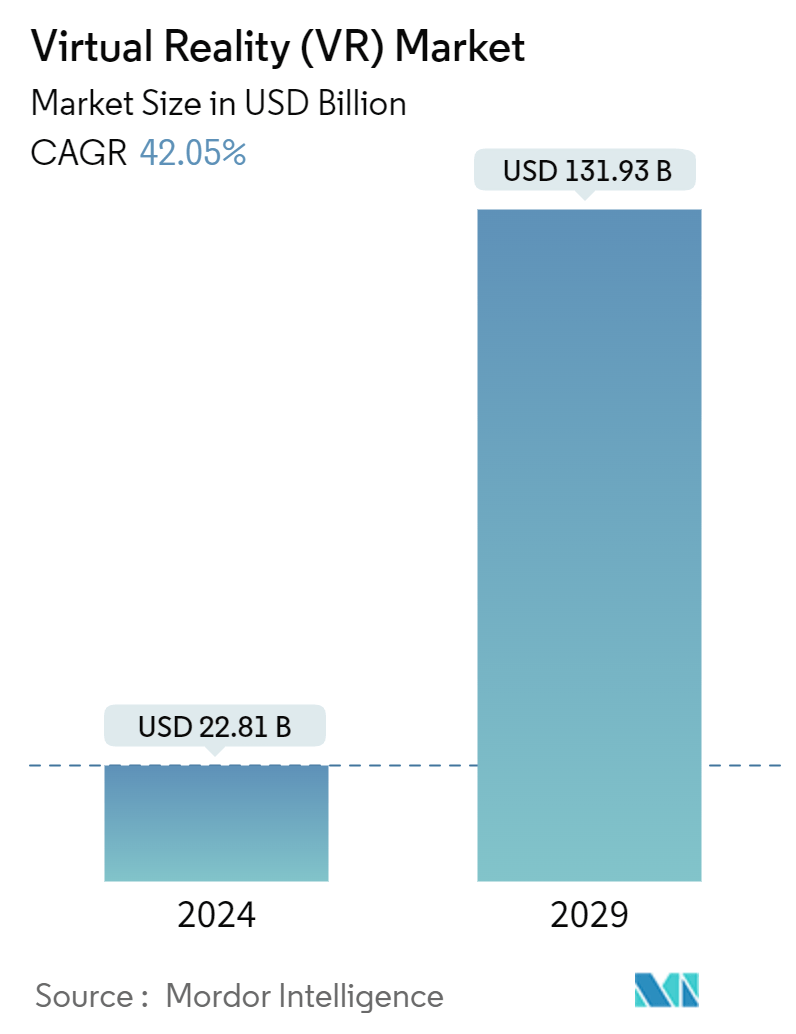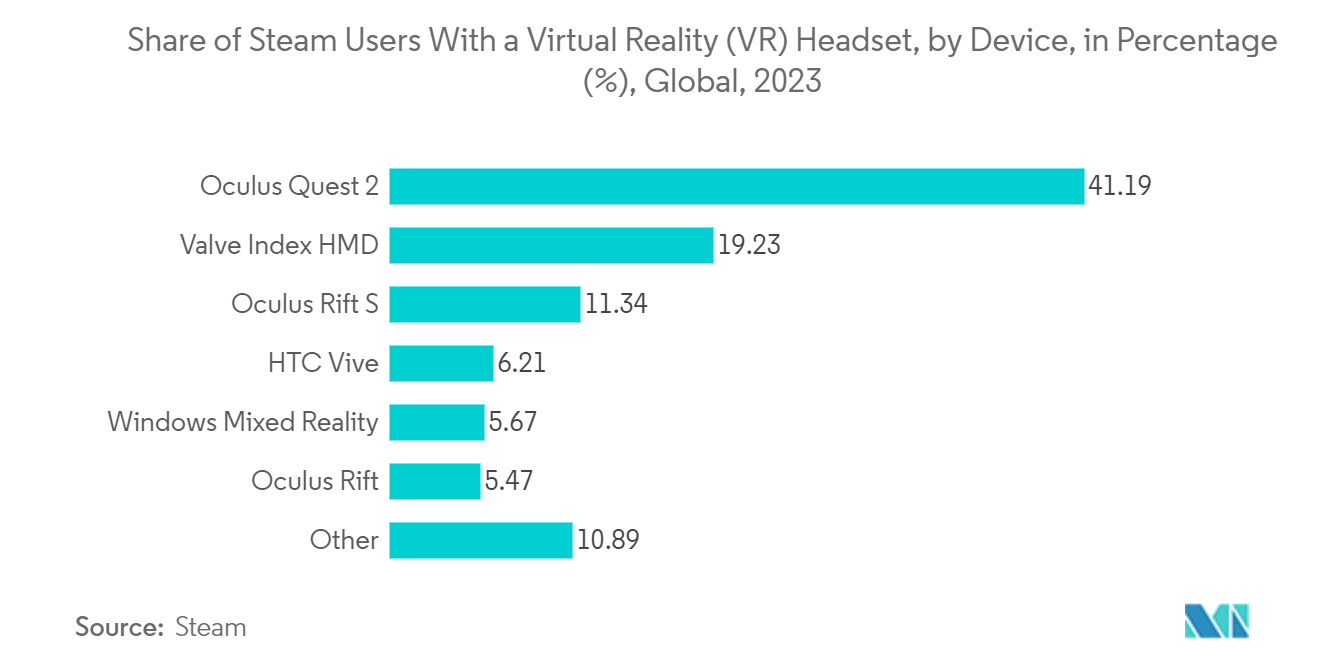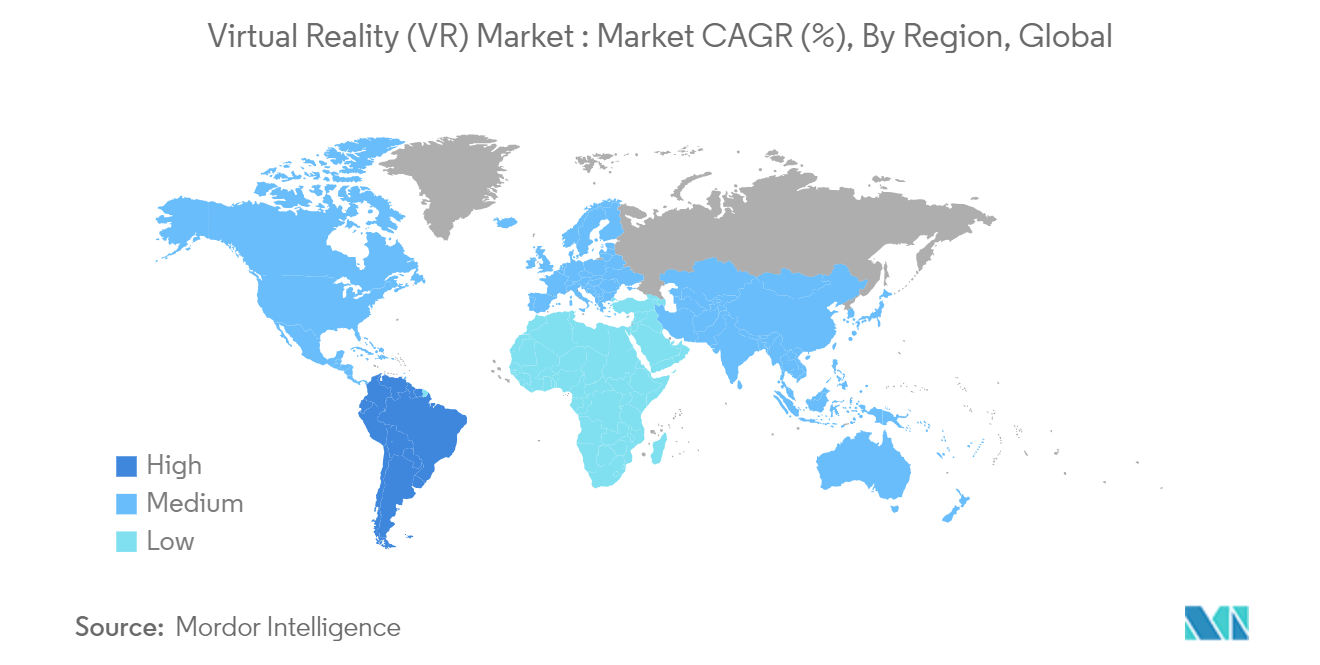Virtual Reality (VR) Market Size

| Study Period | 2019 - 2029 |
| Market Size (2024) | USD 22.81 Billion |
| Market Size (2029) | USD 131.93 Billion |
| CAGR (2024 - 2029) | 42.05 % |
| Fastest Growing Market | North America |
| Largest Market | Latin America |
Major Players_Market_company_logo.webp)
*Disclaimer: Major Players sorted in no particular order |
Need a report that reflects how COVID-19 has impacted this market and its growth?
Virtual Reality (VR) Market Analysis
The Virtual Reality Market size is estimated at USD 22.81 billion in 2024, and is expected to reach USD 131.93 billion by 2029, growing at a CAGR of 42.05% during the forecast period (2024-2029).
Virtual reality primarily uses technology to create a simulated environment. Unlike the traditional user interface, VR places the user inside an experience, which means that instead of viewing a monitor screen in front of them, users are immersed and can interact with the 3D world. With the simulation of as many senses as possible, such as vision, touch, hearing, and even smell, the technology has been transformed across the world.
One of the most popular reasons schools are taking advantage of VR technology is its ability to let students take field trips virtually. Field trips are a time-honored tradition for educational institutions. They allow teachers to educate their students in immersive environments and provide hands-on learning opportunities that would otherwise be difficult to achieve within the classroom. However, field trips can be financially prohibitive for some students. They can also be challenging for students with mobility limitations.
With the rise of remote work and virtual collaboration, a growing demand for VR software enables users to interact and collaborate in virtual spaces. VR meeting platforms, virtual event spaces, and collaborative design tools allow users to work together in immersive virtual environments regardless of physical location. It is also used in various industries, including healthcare, for medical training, surgical simulations, pain management, exposure therapy, and rehabilitation. The demand for VR software in healthcare is driven by its potential to improve patient outcomes, enhance medical education, and reduce healthcare costs, driving its adoption.
Virtual reality is emerging as a revolutionary technology that can notably impact various end-user industries. The technology is witnessing continuous growth, leading to significant expansion in the number of use cases.
VR is usually accessed using a headset that tracks the movement of the head and eye. Some systems also use other peripherals (e.g., gloves) to simulate additional senses. This technology has immense potential to expand human knowledge by changing how people learn, play, work, and entertain themselves. Its adoption has been increasing across various end-user verticals.
The COVID-19 pandemic halted the manufacturing of several products in the semiconductor production industry owing to continued lockdowns in critical global regions. In addition, country-wise lockdowns inflicted by governments across the world further resulted in sectors taking a hit and disrupting supply chains and manufacturing operations worldwide. Most manufacturing operations, including the factory floor work, were significantly affected, resulting in decreased productivity.
Virtual Reality (VR) Market Trends
Gaming to be the Fastest Growing End-user Industry
- Rapid growth in AR and VR gamers worldwide has expanded the market's horizon. According to NewGenApps, a provider of artificial intelligence, machine learning, big data analytics, and AR/VR solutions, the global user base of AR and VR games will increase to 216 million users by 2025.
- Moreover, the increasing demand for video games creates an opportunity for vendors to offer VR headsets. According to the Entertainment Retailers Association, in 2022, British consumers spent approximately GBP 4.66 billion (USD 5.83 billion) on video games, a 2.3% increase from the previous year. Furthermore, in a survey conducted in September 2023, a significant number of Steam users stated that they use VR headsets, and over 41% of them use Oculus Quest 2 VR headsets.
- Strategic initiatives like partnerships, collaborations, and mergers and acquisitions give major market players a significant chance to expand their market presence. For instance, in October 2023, Yudiz Solutions, a leading digital transformation and game development company based in Ahmedabad, showcased its capabilities at the India Mobile Congress 2023 by unveiling a VR combat shooting game in partnership with leading telecom operator Vodafone India (Vi). 5G technology is used to power VR combat shooting games, and users can expect a low latency experience that allows them to be responsive and interactively immersed in virtual reality.
- In October 2022, Microsoft and Meta partnered to provide virtual reality experiences. This collaboration aims to bring Teams' and Microsoft's other productive tools to VR headsets, and Meta will get a partner in its grand metaverse plan. Microsoft and Meta are exploring ways to bring the Xbox Cloud gaming service to the store so gamers can play high-quality XBOX games on smartphones, tablets, computers, smart TVs, or any connected device through a Meta Quest system.
- The gaming industry recognizes the market potential of VR. As the technology becomes more accessible and affordable, the demand for VR gaming experiences is increasing. Game developers and publishers see VR as an opportunity to reach new audiences and create exciting, immersive experiences that stand out in a crowded market.

North America Holds Largest Market Share
- The demand for VR in North America has experienced rapid growth owing to the significant shift in individuals across various sectors engaging with technology. This increasing demand is fueled by the various applications of VR technology, from entertainment and gaming to education, healthcare, enterprise solutions, and others.
- The demand for VR is further propelled by technological advancements, making VR devices more accessible and user-friendly. The affordability and improved performance of VR headsets have contributed to broader adoption across North America, from tech enthusiasts to casual users seeking novel and engaging experiences. Hence, many companies are launching new products to increase their market share.
- Also, as VR becomes more accessible and easier to use, it offers a lot of great possibilities for the government to explore innovative approaches. Hence, the US government uses VR as a valuable tool across multiple sectors. For instance, in September 2023, the US Food and Drug Administration announced that VR could deliver some clinical services, normally delivered only in clinics and hospitals, to patients in their homes or other non-clinical settings.
- Moreover, by the end-user industry, the education sector is expected to grow significantly during the forecast period. North American educational institutions are integrating VR into their curricula to provide students with hands-on, experiential learning opportunities. Virtual field trips, simulations, and interactive lessons enhance the learning experience, making complex concepts more accessible and fostering a deeper understanding of various subjects.
- These factors indicate the growing demand for VR. As VR evolves and becomes more accessible, various industries will shape how individuals and industries interact with the digital era. The trajectory of VR adoption in North America suggests a future where immersive experiences become an integral part of everyday life. Hence, the above-mentioned factors will boost the growth of the market studied in the future.

Virtual Reality (VR) Industry Overview
The virtual reality market is fragmented in nature. It is witnessing a rise in competitiveness among companies as VR companies are focused on accessibility to larger masses through gaming, entertainment, training, marketing, etc. The competitive rivalry is high in this industry, owing to the growing industry. Competition is expected to increase in the future. Some major players include Oculus VR LLC, Lenovo Group Ltd, Samsung Electronics Co. Ltd, Sony Corporation, and Pico Interactive Inc.
- In January 2024, Qualcomm Technologies announced strategic collaborations with RayNeo and Applied Materials to develop and bring the next generation of market-leading AR glasses to market. This collaboration is expected to bring together the expertise of industry-leading technology providers to redefine the future of AR glasses. RayNeo's AR glasses will utilize Qualcomm's Snapdragon AR1 Gen1 platform and Applied Materials' lightweight full-color waveguides to create a comprehensive software and hardware ecosystem for consumer-grade AR products.
- In November 2023, Pico announced the launch of PICO 4, a next-generation, all-in-one VR headset designed to make virtual reality accessible to everyone by combining comfort and performance. PICO 4 is based on the Snapdragon XR2 platform and features an ultra-light body, pancake optics, a 4K display, and an intuitive user interface.
Virtual Reality (VR) Market Leaders
Oculus VR LLC
Lenovo Group Ltd
Samsung Electronics Co. Ltd.
Sony Corporation
Pico Interactive Inc.
*Disclaimer: Major Players sorted in no particular order
_Market_competive_logo1.webp)
Virtual Reality (VR) Market News
- December 2023: EON Reality announced the official launch of EON Reality Oman, marking a significant milestone in the company's ongoing efforts to expand global access to cutting-edge XR technologies. By implementing an advanced XR ecosystem integrated with artificial intelligence, EON Reality aims to contribute to technological development and innovation in Oman.
- September 2023: DPVR announced the launch of P2, the Marathon Kit Enterprise-Grade VR headset for dynamic business solutions. It is designed to cater to a wide range of power needs, from school education and adult technical training to offline VR arcades, elderly care, and meditation. The Marathon Kit assures users of a seamless and enduring power experience.
Virtual Reality (VR) Market Report - Table of Contents
1. INTRODUCTION
1.1 Study Assumptions and Market Definition
1.2 Scope of the Study
2. RESEARCH METHODOLOGY
3. EXECUTIVE SUMMARY
4. MARKET INSIGHTS
4.1 Market Overview
4.2 Industry Attractiveness - Porter's Five Forces Analysis
4.2.1 Bargaining Power of Suppliers
4.2.2 Bargaining Power of Buyers
4.2.3 Threat of New Entrants
4.2.4 Threat of Substitute Products
4.2.5 Intensity of Competitive Rivalry
4.3 Industry Value Chain Analysis
4.4 Assessment of Macroeconomic Factors on the Market
5. MARKET DYNAMICS
5.1 Market Drivers
5.1.1 Increasing Adoption of VR in Commercial Application
5.1.2 Increasing Demand for VR Setup for Training Across Various End-user Segments
5.2 Market Challenges/restraints
5.2.1 Health Risks From Using VR Headsets in the Longer Run
5.2.2 Impact of Cybersickness
6. MARKET SEGMENTATION
6.1 By Type
6.1.1 Hardware
6.1.1.1 Tethered HMD
6.1.1.2 Standalone HMD
6.1.1.3 Screenless Viewer
6.1.2 Software
6.2 By End-user Industry
6.2.1 Gaming
6.2.2 Media and Entertainment
6.2.3 Retail
6.2.4 Healthcare
6.2.5 Military and Defense
6.2.6 Real Estate
6.2.7 Education
6.3 By Geography***
6.3.1 North America
6.3.2 Europe
6.3.3 Asia
6.3.4 Australia and New Zealand
6.3.5 Latin America
6.3.6 Middle East and Africa
7. COMPETITIVE LANDSCAPE
7.1 Company Profiles*
7.1.1 Oculus VR LLC
7.1.2 Sony Corporation
7.1.3 Samsung Electronics Co. Ltd
7.1.4 Lenovo Group Ltd
7.1.5 Pico Interactive Inc.
7.1.6 Qualcomm Technologies Inc.
7.1.7 FOVE Inc.
7.1.8 Unity Technologies Inc.
7.1.9 Unreal Engine (Epic Games Inc.)
7.1.10 Apple Inc
7.1.11 DPVR (Lexiang Technology Co. Ltd)
7.1.12 Autodesk Inc.
7.1.13 Eon Reality Inc.
7.1.14 3D Systems Corporation
7.1.15 Dassault Systemes SE
7.1.16 HTC Vive (HTC Corporation)
8. INVESTMENT ANALYSIS
9. FUTURE OF THE MARKET
Virtual Reality (VR) Industry Segmentation
Virtual Reality (VR) technology, a computer-simulated reality creating an artificial environment, is increasingly used in sectors like education, gaming, and AI applications. This immersive multimedia offers a 3D virtual world, enhancing learning experiences and gaming environments. AI integration further enriches the virtual environment. The development of the metaverse, a collective shared space combining VR, augmented reality, mixed reality, and brain-computer interface, promises an interactive virtual reality experience. The gaming sector dominates the VR market segmented by hardware, end-user, and geography, with North America leading due to numerous startups focusing on computer-generated reality technologies.
The market is defined by the revenue accrued from the sale of virtual reality solutions to different end-user verticals across the world.
The virtual reality (VR) market is segmented by type (hardware [tethered HMDs, standalone HMDs, screenless viewer] and software), end-user industry (gaming, media and entertainment, retail, healthcare, military and defense, real estate, and education), and geography (North America, Europe, Asia-Pacific, Latin America, and Middle East and Africa). The market sizes and forecasts are provided in terms of value USD for all the above segments.
| By Type | |||||
| |||||
| Software |
| By End-user Industry | |
| Gaming | |
| Media and Entertainment | |
| Retail | |
| Healthcare | |
| Military and Defense | |
| Real Estate | |
| Education |
| By Geography*** | |
| North America | |
| Europe | |
| Asia | |
| Australia and New Zealand | |
| Latin America | |
| Middle East and Africa |
Virtual Reality (VR) Market Research FAQs
How big is the Virtual Reality Market?
The Virtual Reality Market size is expected to reach USD 22.81 billion in 2024 and grow at a CAGR of 42.05% to reach USD 131.93 billion by 2029.
What is the current Virtual Reality Market size?
In 2024, the Virtual Reality Market size is expected to reach USD 22.81 billion.
Who are the key players in Virtual Reality Market?
Oculus VR LLC, Lenovo Group Ltd, Samsung Electronics Co. Ltd., Sony Corporation and Pico Interactive Inc. are the major companies operating in the Virtual Reality Market.
Which is the fastest growing region in Virtual Reality Market?
North America is estimated to grow at the highest CAGR over the forecast period (2024-2029).
Which region has the biggest share in Virtual Reality Market?
In 2024, the Latin America accounts for the largest market share in Virtual Reality Market.
What years does this Virtual Reality Market cover, and what was the market size in 2023?
In 2023, the Virtual Reality Market size was estimated at USD 13.22 billion. The report covers the Virtual Reality Market historical market size for years: 2019, 2020, 2021, 2022 and 2023. The report also forecasts the Virtual Reality Market size for years: 2024, 2025, 2026, 2027, 2028 and 2029.
What are the key industries driving the growth of the VR adoption?
Key industries driving the growth of the Virtual Reality (VR) adoption include gaming, education, healthcare, and automotive sectors. Each sector utilizes VR for different purposes, from training and simulations to marketing and design.
Virtual Reality (VR) Industry Report
The VR market is witnessing significant growth, fueled by its expanding applications across various sectors including gaming, entertainment, healthcare, military, and education. Virtual Reality (VR) technology, known for creating immersive environments, is increasingly adopted for training, medical procedures, and customer engagement. The demand for VR is segmented into hardware, software, and content, with hardware, especially head-mounted displays (HMDs), expected to dominate due to their immersive experience capabilities. The gaming and entertainment segments are major drivers of market growth, while the healthcare sector is leveraging VR for surgical training and patient care. North America leads the market, with Asia Pacific experiencing rapid growth due to advancements in network infrastructure. Challenges such as health concerns associated with prolonged VR use persist, yet the market's potential in live virtual entertainment and healthcare applications continues to fuel its expansion. For detailed statistics on the Virtual Reality market share, size, revenue growth rate, and a market forecast outlook, refer to Mordor Intelligence™ Industry Reports, offering comprehensive analysis and a free report PDF download.
